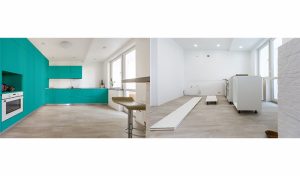How do you pick countertop materials that are environmentally sound? Homeowners who want beautiful stone countertops increasingly ask this question. Any material that you choose has environmental costs in harvesting or manufacturing, preparing it for use, and transporting it to the final site. Some countertops are fastened to the top of the cabinets with adhesives that may affect their quality, and some materials may require periodic sealing with chemicals. These are all considerations for choosing environmentally friendly products.
Assessing the Greenness of Granite Countertop Materials
How do three popular countertop surfaces – granite, quartz and concrete – compare in terms of environmental impact?
Granite, the most popular countertop choice in the U.S, is a natural material that must be extracted from the earth in energy intensive operations. It is not renewable or recyclable, although slabs no longer used as countertops can be cut down for other purposes. Found throughout the world, it must be transported to the site, which adds emissions to the air. By choosing granite quarried in the United States, you can minimize transit costs and help the environment.
To prepare the product for installation in your home, the technician will grind and saw it into shape, which sends dust into the air, but not volatile organic compounds (VOCs); fears that it might send off radon have been largely put to rest. The granite needs sealing to protect it from stains, but there are water-based sealers available to minimize VOCs. Once installed, granite is long-lasting and ceases to have an ongoing environmental impact.
Quartz Becoming a Popular Green Choice
Quartz countertops are engineered stone product made from quartz waste from other mining operations, polyester resin, and dyes. Now challenging granite as a popular countertop material, quartz uses regionally quarried stone and is processed by fabricators who pride themselves on using environmentally sound treatment and manufacturing processes. Pigments and the resin used to bind the color to the quartz have an unknown environmental impact, but the amount used is small. Quartz is considered to be a green product.
The product offers low VOC omissions and needs no sealing. While quartz must be mounted on a subtop before attachment to the counter, both the plywood and adhesives used can be specified to be free of formaldehyde and other toxic chemicals.
Concrete, the Rising Countertop Star
Concrete countertops, which are an increasingly popular choice, are made from cement, aggregate, and water. They contain a high percentage of recycled material and can later be recycled again. They can be colored with natural pigments mixed into the concrete rather than chemical surface stains. The energy required to produce cement, along with the transit costs, are the biggest environmental impacts, but by using local fabricators, you can minimize the cost of transportation.
The material produces no off gassing, although installation generates a high amount of dust. While the counters need periodic sealing, many water-based low chemical products are available.
The Ultimate Way to Be Green
Buying locally harvested and processed countertop materials is the best way to minimize environmental impact. If you ask the right questions of your countertop supplier, you can find the greenest product in the material you desire. However, since countertops are a long-term investment, one of the best ways to respect the environment is choose a countertop – like granite, quartz or concrete – that will last you for many, many years. In fact, these materials will usually last the lifetime of the home if they are properly installed and maintained. So long as you choose a lasting style versus a trendy design that you’ll want to change in a few years, any countertop material you choose will be environmentally-friendly.
For the best in green countertop materials and expert installation, contact Mountain States Kitchen and Bath today to come and view our selection.








